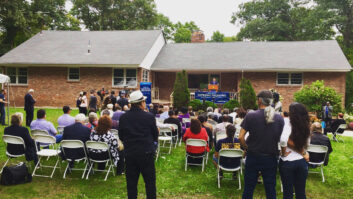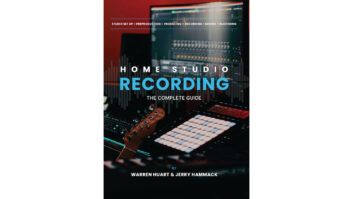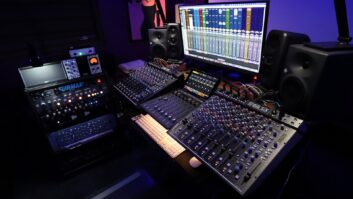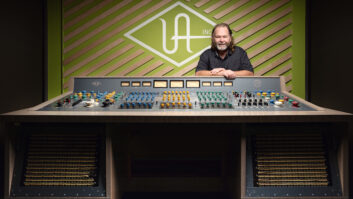The Toy Specialists has been a Manhattan fixture for the past 15 years, supplying major studios in the area with the equipment that top-shelf producers and artists (Phil Ramone, David Bowie, Whitney Houston, et. al.) need to get the exact sound they’re looking for. Bill Tesar, owner of Toy Specialists, was recently tapped to go the extra mile and create a studio from scratch for the jam band Phish, who wanted to record in their native Vermont, outside of a conventional studio. The result? A temporary studio built in a barn.
Tesar describes how the assignment came about and the challenges that were involved: “Phish has been a client of ours for the past few years. We had previously rented them equipment for recording projects, and we’ve executed a number of audio transfers in our transfer facility, The TransferMAT-notably for their live European tour. Phish decided that they would prefer to record their next record in their own environment and contacted us with the idea. We immediately rose to the occasion. Most of the equipment was pulled from existing inventory. We had provided them with some new pieces, notably a Studer A827 ‘Gold’ edition 2-inch, 24-track recorder and an Ampex ATR-102, hot-rodded by Mike Spitz of ATR Service. Then we scoured the country for the only missing item from our inventory, a suitable console. [They brought in an API Legacy.]”
The band used a variety of formats on the project-for example, Pro Tools|24 with Apogee AD-8000 converters, an Otari RADAR II 48-track hard disk system, as well as the analog 2-inch machine. Two-track recorders covered the gamut, from half-inch analog to CD-R to DAT and cassette. There was also a full complement of outboard gear, including Pultecs, EAR 660 and Smart compressors, UREI LA-3As, 1776LNs, numerous effects devices and Lexicon reverbs, etc. Toy Specialists also provided a complete range of microphones. All of the equipment will go back out on other projects.
“The biggest challenge was making sure that the entire installation was completed on time and that it met the critical performance standard that anyone would expect from a first-class studio,” Tesar says. “Thousands of connections were tested and re-tested, and the entire ground scheme needed to be flawless. The client did not have the luxury of a technical staff on hand, so everything needed to be perfect. I should mention that there were no technical problems throughout the project.”
Toy Specialists VP of sales and marketing Mark McKenna, who logged a considerable number of hours on the project, agrees that the devil was in the details. “Beyond finding the right console, the biggest challenges were connectivity and equipment maintenance,” he says. “We had to fabricate patchbays and cabling suitable for this as well as future, unknown applications. In addition, the console had to be shipped from Florida to Vermont and then commissioned by us and API onsite. Since we supplied the entire studio package, we were responsible for every aspect of the studio’s performance, from the noise floor of the console right down to flushing out ground loops in the outboard gear. They also elected to use three different recording formats: analog 2-inch with SR, Pro Tools|24 MixPlus and RADAR II. This added a high degree of complexity to the proceedings.”
Tesar points out that a deal was laid out from the beginning to make the purchase of gear used on this recording available to Phish. “It should be noted that we structured a rent-to-buy situation for the 64-input, fully automated, API Legacy console. The client exercised that option at the backend of the rental. They were able to apply a percentage of the rental toward the purchase. This is something that we will arrange for our customers on large pieces of equipment, rented over a period of a few months.”
Phish producer Bryce Goggin told Mix that the band wanted to eliminate the gap that has existed between the kind of energy they express in live performance and the results they’ve gotten out of the traditional recording process. “Phish has always felt that their studio efforts have fallen short of representing much of what the band achieves musically in a live concert performance,” he explains. “By creating a studio in an unconventional space we were able to dispense with much of the formality of the recording process, which has in the past dampened the spontaneity of their recording experience.
“Trey Anastasio [guitarist for Phish] built the barn we were recording in and had rehearsed the band in the space during the course of the previous year,” Goggin continues. “There’s no doubt that the success of these rehearsals and the aesthetics of the surrounding property swayed us all to remain at the location for the recordings.”
As comfortable as working near home must have been, creating a studio for a single project must have involved certain compromises, so I asked both Goggin and engineer John Sycket about that issue. “All our design specifications were geared toward ergonomics; we had no control room and therefore dispensed with the fantasy of isolation from the band themselves,” Goggin notes. “Any attempts to acoustically modify the environment were made in order to enable some degree of isolation for the instruments themselves. This involved the use of Taytrix baffles and sound blankets.”
“As always in this kind of situation, I was apprehensive about not having a control room, but the band really wanted to record that way, and so I had to adapt,” adds Sycket, who was working at Bearsville Sound Studios when we caught up with him in December. I asked Sycket to compare the results with those he might have expected to get if the album were tracked and mixed in an “A” studio: “Things turned out pretty well, actually, but we’re going back in January, so there’s a good chance we might tweak the mixes, as well as do some additional recording.
“I like the aspect of Phish that lets them combine focused pop songs and psychedelic extended jams-both coexisting on a single album,” Sycket adds. “They’re able to take these elements and create a cohesive album.”
As for Goggin’s overall assessment of recording in such an unusual fashion, he notes, “For my needs it was about an 8.5 on a scale of one to ten. The job got done and most of the hitches were due to labeling anomalies in the patchbay, which were unavoidable due to the rapid way in which things were put together. Would I work this way again? Seat-of-the-pants recording is fun and stimulating; I hardly ever work any other way!”
As for the crew at Toy Specialists, Tesar says that setting up a temporary recording studio for Phish left his staff convinced that they can duplicate the experience for other clients with highly satisfactory results. “We came away from this project with the confidence that we can and will repeat this situation,” he says. “Preplanning was the key for us. Because we have a very large space, we were able to set up the entire studio in our facility beforehand and test it. Then, we disassembled the entire thing, including the console, and reinstalled it onsite. This allowed us to see just what we would be up against logistically. The entire setup took two days with three people. If we had more time up front to custom-fabricate some of the wiring looms and panels, we could have set the entire studio up in a day and a half. We are very excited about offering a tailor-made situation for people to record in. Artists can now record wherever they choose, with the equipment they want, in a custom package. The creative benefits are obvious.”
The new Phish album, still untitled at press time, should be out later this spring on Elektra. Their most recent release was the impressive six-CD live set Hampton Comes Alive, which consists of two complete concerts recorded in Hampton, Va., in 1998.







